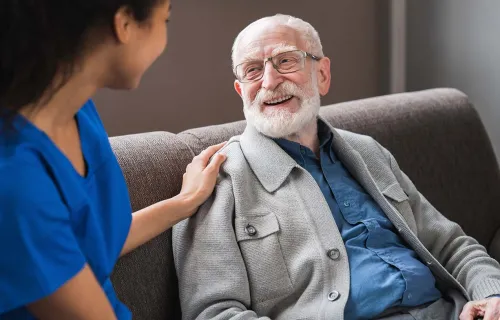The King’s Fund estimates that the NHS has 1.6 million interactions with people every single day.1 This contact between citizens, patients, their circles of care, and staff, as well as the processes and systems enabling them, is driving the pursuit of modernised, accessible and higher-quality care by the NHS. But so far, multiple levels of structural reform have failed to provide the level of radical change required to sustain service levels.
Now more than ever, the system needs to transform. But where do we begin?
I believe the future of health and care lies with people, as each interaction with the system provides an opportunity to gain invaluable insights from those involved. Using platforms such as Patient Opinion, the Patient Advice and Liaison Service (PALS), or the NHS Complaints process, we can capture people’s feedback to understand their experiences, and use that to create real, impactful change across the sector.
Unfortunately, these channels often face a deluge of negativity, and though lessons can be learnt, the valuable insights can be obscured by judgement. Imagine however, if we adopted a routine weekly review or “mystery shopper” approach. This would flag early indicators of complaints or negative experiences, whilst providing learning opportunities from those using services. Furthermore, engaging in two-way communication is a powerful tool in informing service users and fostering a more constructive relationship between citizens and healthcare providers.
What is service design in health and care?
Gaining considerable traction across various industries in recent years, service design is an approach that places people at the heart of the design process. It prioritises their needs, desires, challenges, and experiences to create more meaningful change, and unlike co-design or co-production which focuses on just one aspect of an organisation (such as remote monitoring pathway or a single product outcome), service design takes a whole system view.
Service design therefore has the power to unlock transformed experiences across the entire health and care ecosystem. As a trusted advisor to the sector, we recommend this human-centred approach is used to reimagine healthcare journeys, with people and process considered first, then technology.
People – Without this crucial first step, any attempt at change is bound to falter. A people-first approach facilitates meaningful collaboration, enabling us to capture valuable insights from all stakeholders to inform effective change. We must also foster a mindset and behavioural shift in service users to create a transformative culture where embracing improvement is the norm.
Process – For effective, long-lasting changes to healthcare outcomes, the processes and care pathways must meet the needs of service users (staff and citizens) as well as the wider organisation. By deeply understanding the human needs and challenges to address, we can redefine services for all involved.
Technology – By harnessing the people and process steps first, we can then determine the infrastructure requirements and develop solutions that truly enhance organisational outcomes. From solutions that improve accessibility, to digital health platforms that facilitate self-management, technology will transform experiences of the sector.
5 ways service design can transform healthcare experiences
1. Enhance citizen and patient experience
By actively engaging patients and understanding their unique needs, we can enable change that improves outcomes. From streamlining appointment scheduling, to personalised care plans, a focus on empathy and experience within service design will enable us to create services that cater to people’s needs, fostering satisfaction and trust.
2. Address health inequalities
Equity and inclusivity are essential to closing the health divide. Access to services is therefore a source of great frustration for users and remains one of the top priorities for Government and health and care organisations. A people-centric service design approach gets right to the heart of the problem; it promotes a more holistic approach that extends beyond treating illness, integrating prevention and wellness into services to maintain health and prevent future issues.
3. Reduce demand on services
Exacerbated by the COVID-19 pandemic, the sheer pressure on services is unrelenting. A service design approach identifies the pain points and challenges experienced across care pathways and services, helping to generate ideas and apply digital solutions to simplify operations. By removing unwarranted variation and non-value add activities, staff can be empowered to focus on delivering quality outcomes.
4. Improve workforce satisfaction
Listening to employees is the best way to understand the problems they face day in, day out. Studies highlight frustrations with a lack of interoperable systems, leading to high volumes of paper and manual workarounds with duplicated information across multiple systems. By engaging the workforce to consider their insights and expertise in the design process, we can optimise workflows, lessen administrative burdens, and ultimately reduce the pressure they feel. This will also help improve the quality of care they deliver.
5. Better financial sustainability
There are many variables and factors which cause financial challenges. Applying a service design approach to transform business operations will remove unnecessary steps, eliminate non-value add activities and streamline health and care pathways, helping to realise efficiencies for further reinvestment or savings opportunities.
Navigating the health and care transformation journey, together
I believe the journey towards a more modern, accessible, effective, and empathetic NHS should be powered by human-centred service design. That’s why we use a people, process, then technology approach to support health and care clients at CGI.
With our service design expertise, citizens will receive more personalised, efficient care, and staff will be empowered to deliver their best work. Furthermore, we help organisations to become more agile and adaptable, better equipped to continuously evolve to meet the ever-changing needs of stakeholders.
If you want to learn more about our vision for the future of health and care, and how we can support the human-centred service design journey, read our brochure. Or please click here if you’d like an informal chat about our service offerings.








